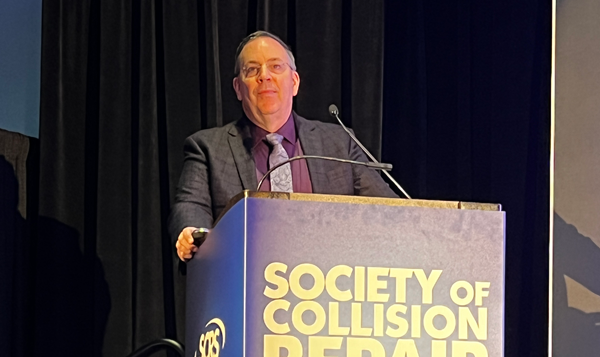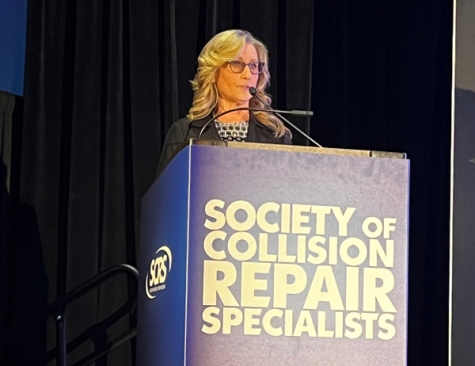Total losses, the Database Enhancement Gateway, computer vision and sustainability were some of the topics discussed during the IDEAS Collide Showcase held during the 2021 SEMA Show.
First introduced in 2018 by the Society of Collision Repair Specialists (SCRS) as part of its Repairer Driven Education (RDE) series, IDEAS Collide gives thought leaders from across the collision repair industry the opportunity to share innovative ideas.
This year, eight speakers talked about creative ways to help the industry evolve. This is part two of a two-part series. Read part one here.
Sandy Blalock, executive director of the Automotive Recyclers Association (ARA), talked about the shared challenge the industry is facing with an increase in total losses. She hopes the different segments can generate thought-provoking ideas on how to make meaningful changes.
“No matter what side of the issue we are, there is a consumer who has suffered a loss and it’s our collective job to find a way to make them whole again,” said Blalock. “Jeff Peevy [previous CIC chairman] will always remind us never to forget that empty chair; we all serve the consumer.”
Blalock said total loss frequency has been rising over the last several years in the U.S. According to CCC Intelligent Solutions’ 2021 Crash Course report, 20.5% of vehicles were deemed total losses in 2020.
“This means that shops missed out on the chance to repair one in every five vehicles,” said Blalock.
This is up from 15% in 2010. The average totaled vehicle in 2020 had an actual cash value of $10,444; the average repairable vehicle was worth $16,657.
In addition, repair costs have also risen.
As insurance adjusters determine whether a vehicle is repairable or declared a total loss, Blalock said a number of factors weigh into the decision, including supplements and parts availability.
With more electric vehicles and cars with ADAS coming into collision repair facilities, Blalock said scanning and calibration will be required, adding additional costs to the repair and determining whether the car is a total loss. Repair vs. replace and salvage values will also play a role.
She shared some of the downsides to total loss, including the consumer owing more on the vehicle than it’s worth and fewer vehicles being fixed by the professional repair industry and auto recyclers.
“Total loss does not mean end-of-life for a vehicle,” she said. “Repaired vehicles will be repaired by someone.”
From her research, Blalock has found as many as one out of 325 vehicles on U.S. roads today may be operating with a fraudulent title that has been “washed” to disguise the vehicle’s actual damage, flaws or identity. Research shows one in five vehicles sold outside of licensed dealer networks are not legal private property car sales, but are illegal sales of curbstoned vehicles.
“Curbstoning is essentially a flipping of vehicles often posing as a private seller,” she explained. “Many of these vehicles have been purchased at salvage auctions by unlicensed entities, repaired and usually not to any industry standard, then sold to some unsuspecting consumer looking for a good deal.”
Blalock advises the industry to be aware of these issues and work together to come up with ways to address them.
As the administrator for the Database Enhancement Gateway (DEG), Danny Gredinberg shared information about the free industry resource.
The DEG was developed to help improve the quality and accuracy of collision repair estimates through proactive feedback from the collision repair industry and other “end users” to the Information Providers (IPs) that supply the databases for the various estimating products. It is created, equally funded and maintained by the Alliance of Automotive Service Providers (AASP) and SCRS.
With today’s estimating databases being large and complex, the task of building complete and accurate labor times and labor notes for vehicles can be challenging. All three information providers use a variety of methodologies to develop labor values. Gredinberg said this can often result in information that does not reflect real-world labor requirements of a repair operation. As a result, it can hinder the ability of an estimator to produce accurate repair estimates or blueprints that match the repair process.
The DEG is designed to offer estimating system users a more standardized and streamlined process for generating Database Inquiries (DI).
Danny Gredinberg, administrator for the Database Enhancement Gateway (DEG).
“It can help anyone to improve an estimate whether it’s a repairer, technician or even a bill payer,” said Gredinberg. “If they find an error in omission or accuracy in any of three estimating systems, we can help address those concerns and get accuracy.”
As the DEG administer, Gredinberg receives a lot of inquiries. One of the biggest challenges he sees is when a repairer writes an estimate in one database program and receives an insurance company estimate from another database program and nothing matches.
“The reality is that we’re never going to get an exact result from three different database products,” said Gredinberg. “They all talk differently and have different logic and P-pages. They will never line up to each other.”
He said it’s the estimator’s job to understand the system they are using in order to explain and justify the estimate to the vehicle owner.
Gredinberg encourages repairers to talk to vehicle owners on the front end, use the estimating system the way it is intended, and capture all of the included and non-included items.
“At the end of the day, the goal is for the consumer to get their vehicle fixed with the least amount of friction possible,” he said.
Pete Tagliapietra, product director at NuGen IT, an OEC Company, talked about leading-edge technologies, such as machine learning, computer vision, robotics automation and artificial intelligence (AI).
“What’s unfortunate to me is how these technologies seem to be left behind as far as collision repairers are concerned,” said Tagliapietra.
He challenged collision repairers to think outside of the box.
Tagliapietra shared an idea of using these technologies to capture images of a damaged vehicle and immediately access all of the OEM information required by a collision repairer to repair it.
Pete Tagliapietra, product director at NuGen IT, an OEC Company.
In the current environment, Tagliapietra said repairers have access to individual OEM repair information through the manufacturers’ websites. However, each OEM has its own format, and repairers often don’t know what to look for and where to find it. Alternatives include accessing information through OEM 1Stop; a third-party provider, such as ALLDATA or Identifix; or via estimating systems repair lines.
He talked about the possibility of accessing OEM repair information via computer vision. In this scenario, digital images of the vehicle damage would be uploaded to a computer vision central server. Once the images are analyzed, a collision shop could have the information available through the OEM website or a third-party provider within seconds.
“The premise of the idea is to give collision repairers all of the information needed to create a complete blueprint of the automobile before the estimate is written,” explained Tagliapietra.
In addition, reporting capabilities would be available. “Over time, you would be able to look at a certain year, make and model and understand what repair procedures are typically being used to repair that vehicle.”
Tagliapietra said all of this is possible with the technology available today.
“When you look at all of the different repair information opportunities, none of them bring all of the information that you need as a collision repairer to have access to them,” he said.
By using computer vision, Tagliapietra said collision repairers would immediately know all of the necessary repair procedures to include if a pre-and post-scan is required, as well as a recalibration. They would also have access to manufacturers’ position statements before writing the estimate and repairing the vehicle.
He encourages the industry to leverage the same technology used by other industries, such as insurance.
“Dreaming big is something we need to do in this industry,” said Tagliapietra. “Otherwise, we’ll fall behind and, in some cases, fall further behind.”
Michael LoPrete, vice president of global operations at Plastfix Inc., talked about sustainability and the future impact on collision repairers.

Michael LoPrete, vice president of global operations at Plastfix Inc.
LoPrete shared a broad definition of sustainability, which he described as meeting the needs of the present without compromising future generations’ ability to meet their needs.
“I think about sustainability as a journey to a place where we are able to complete vehicle repairs while eliminating all of our current waste streams,” said LoPrete. “I don’t think that there is a point that we’ll ever be finished.”
He shared what he referred to as the 3R’s of sustainability, in order of importance: reduce, reuse and recycle.
Examples of reduce include repairing something rather than replacing it, and conducting online training rather than incurring travel time. Reuse also refers to repair vs. replace, and LoPrete used the example of purchasing a new cell phone as soon as it is introduced, even if a person’s current device is working perfectly well. Recycling is often the first thing that comes to mind when people think of sustainability, but LoPrete said it has the smallest impact on sustainability initiatives.
He introduced the term “recoverability,” which he described as an item that has the capability of being recycled and then converted to a new product of the same type, such as glass or aluminum.
“The recoverability rate on those items is nearly 100%,” he said. With plastics, recoverability is less than 5% and includes specific products such as water and soda bottles.
The automotive aftermarket is reportedly the No. 2 generator of polypropylene waste globally and recoverability is close to 0%.
LoPrete said green consumers are driving the increased awareness of sustainability, and Greta Thunberg is a leading spokesperson for Generation Z.
“Generation Z looks at the world through the lens of the sustainability triple bottom line, which includes economy, environment and society,” he said. “Every decision they make tends to have filters that pass through all three of those things.”
Many say Generation Z is demanding industries be more responsible and accountable for their actions.
“The ones who do it in a meaningful way are positioning their businesses well to move forward,” he said. “The ones who delay taking action will have to catch up eventually because that segment of the population is only going to become a larger and larger piece of the audience out there.”
Moving forward, LoPrete encourages industry stakeholders to work together and make sustainability part of their strategic thinking to reduce the amount of waste being generated while still producing safe repairs.
“While we can do things individually that will make a difference, the reality is that the greatest impact will come if we work together,” he said. “Sustainability needs to be a topic of discussion; it can’t be left undiscussed.”
He challenged the industry to do the following:
- Make sustainability an agenda item during meetings
- Appoint a subject matter expert within your organization
- Track and record your current waste and look at trends
- Identify pathways for improvement
- Involve other stakeholders in your conversations
- Share initiatives broadly across your organization
“If we begin thinking about sustainability from this perspective, we can make progress that will shape legislative actions, rather than being subjected to requirements from outside of our industry,” said LoPrete. “There will be winners and losers across the stakeholder chain. The green consumer will make sure that happens. They will support the ones that make the right choices.”
Learn more about the SCRS Repairer Driven Education series here.











Stacey Phillips Ronak